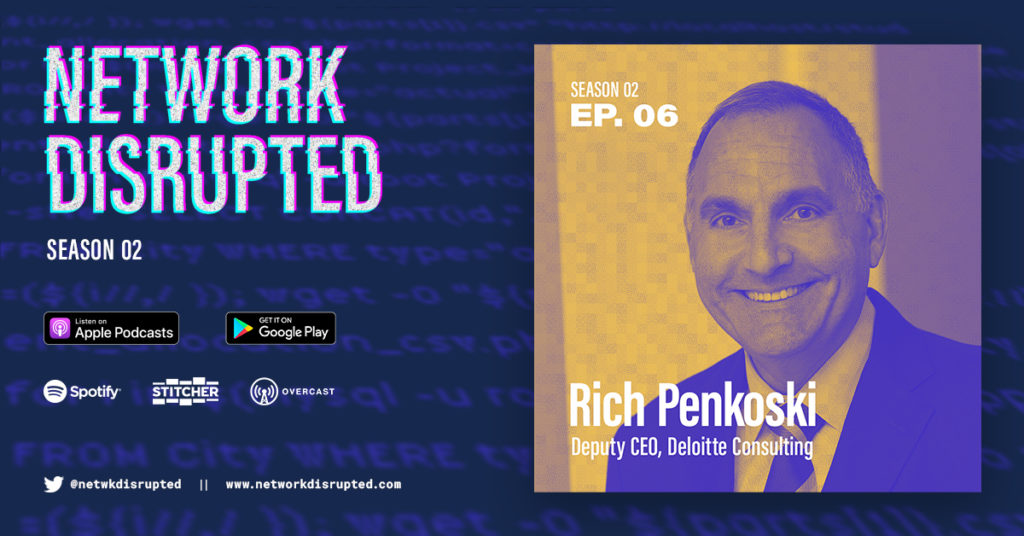Deloitte Deputy CEO on CIO’s shift to business partner
Deloitte’s Rich Penkoski sees CIOs shifting to be business partners instead of technology providers, embracing agile project approaches, and more.

If we’ve been reminded of anything this year, it’s of how quickly everything can change. Deloitte’s Principal and Deputy CEO of Markets, Rich Penkoski, highlights what that means for today’s CIOs, especially in their relationships with the rest of the C-suite.
For years, Penkoski has watched how the role of the CIO has changed. Lately, he’s seen CIOs moving to become executive-level business partners instead of technology providers and seeking non-technical attributes in new hires.
Furthermore, shifts in technology have wedged open the door for IT to partner with finance and have brought massive shifts to traditional IT project management approaches.
Below are the insights he shared with host and BlueCat Chief Strategy Officer Andrew Wertkin during the second season of the Network Disrupted podcast.
An opportunity and a wake-up call for CIOs
According to Deloitte’s research, CIOs are more frequently reporting directly to the CEO instead of the CFO. Further, most CEOs today see their CIO as one of the most mission-critical members of their team when it comes to formulating strategy—more so than the CFO or COO. And, Penkoski notes, CIOs are getting a seat at the boardroom table more than they ever did before.
This shift highlights just how much value CIOs can bring to their organizations. It represents an opportunity for some, but a wake-up call for others.
Previously, CIOs were tasked with providing the technology that would support the business architecture. Now? It’s essential that CIOs see that they are an integral part of business strategy. The CIO must be the voice that informs his or her peers about technology developments and how those can help the organization achieve its strategic goals.
Penkoski says some businesses may be looking at the reality of the CIO’s criticality and reconsidering whether they have the right technology professional in the right seat. They’re looking for someone who’s looking towards the future, not rooted in the past. Much like Jason James at Net Health is seeing hiring from outside industries to foster change, these days, Penkoski sees some organizations even looking outside of IT for hires.
What CIOs want in a new hire has changed
In the 1990s, businesses were looking to hire people with deep, specialized knowledge of particular technologies. Thirty years later, according to Deloitte research, the three most important things that CIOs are looking for in a great hire are:
- creativity,
- cognitive flexibility, and
- emotional intelligence.
They still need a deep knowledge of technology, says Penkoski. But these three traits are seeing double-digit growth in popularity.
Undercapitalized relationship potential between IT and finance
There is a common trope that IT and finance are constantly at war about spending. But the potential of these two departments to collaborate more meaningfully cannot be overstated.
As Penkoski points out, the finance department has often been used as an incubator for new technologies. After all, they’re the ideal department for IT to work with. Analytics are essential, and finance has complete ownership over their data.
As a result, we’ve seen many consumer finance products become better through partnerships between finance and IT.
As CIOs move more into the role of a business partner instead of a technology provider, they stand to significantly help the finance team leverage technology more strategically. The lines, Penkoski says, between what people in IT do and what people in finance do are starting to blur. That’s a good thing.
From the Project Management Office to the Value Management Office
The waterfall methodology, a linear approach to project management, has been prominent for years. But the agile methodology, which is focused on iterative development, is spreading through teams and large corporations, completely changing the way they operate. So completely that even annual planning and budgeting processes are now evolving, Penkoski notes.
A long and sequential process that originally favored the careful outlining of the project, scope, length of time, milestones, and more is becoming more agile. Penkoski says he is seeing the growth of the VMO, the Value Management Office, in place of the traditional Project Management Office.
Instead of presenting a long-term project set and allotting a portion of the budget towards that (which is difficult to do accurately and efficiently in the best of times), VMOs are bringing together stakeholders to allocate each dollar of investment across the IT stack in a more real-time way. Below is his explanation.
Make IT “Apple-easy and Google-fast”
Another trend Penkoski noted is just how much consumer products have affected how users interact with—and what they expect from—IT. Employees today want the technology they use at work to feel and operate exactly like their own personal devices do.
In a recent transformation program he oversaw for a finance company, Penkoski says the CFO asked for a system that’s “Apple-easy and Google-fast.”
This has put a lot of pressure on IT. Even when IT departments want to deliver a consumer-esque user experience for employees, says Penkoski, they’re held up by practical and security concerns.
These things have to be cyber-secure, they have to be scalable in the organization, and be maintainable.
Penkoski reminded listeners that balancing user experience with meeting security and budget requirements is difficult. The pressure won’t ease on either end.
Though it’s challenging to integrate the two ideas, Penkoski says the “consumerization of IT” has made it an exciting time for IT professionals. They’ve got the chance to have a career that pushes them to be equally tech-savvy and business literate, which will make them a valuable asset in the future.
If you’d like to hear more of Rich Penkoski’s episode, find it below on the Network Disrupted Podcast.




